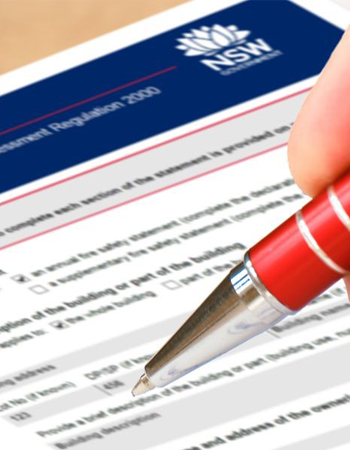
WHAT IS AN ANNUAL FIRE SAFETY STATEMENT?
An Annual Fire Safety statement is starts of as part of the construction of a building, Multiple Essential Fire Safety Measures are installed in order to comply with the Building Code of Australia (BCA) or the National Construction Code (NCC). These essential fire safety measures may include a range of items such as fire extinguishers, fire hose reels, exit and emergency lighting, fire detection systems and fire sprinkler systems or hydrants systems or pump sets. The measures will be listed in the Fire Safety Schedule of the Development Approval or Construction Certificate.
Once the completion of the building works, the building owner (or their agent or strata management company) is required to submit a final Fire Safety Certificate to their local Council before an Occupation Certificate can be issued. This final fire safety certificate is a declaration that each of the specified essential fire safety measures listed in the Fire Safety Schedule have been installed and are capable of operating to their required minimum standard of performance.
In preparing this certificate, the building owner/owner’s agent/strata obtains certification from the designers and installers of each safety measure that these standards have been met, for example, AS1670.1 for fire detection, AS2444 for Fire Extinguishers or AS2118 for fire sprinklers.
Every twelve months after the building is completed the Environmental Planning and Assessment Regulation 2017 requires an Annual Fire Safety Statement be prepared and forwarded to Council along with the existing Baseline Data, Fire Safety Schedule. A copy needs to be sent to the fire brigade and a further copy displayed in the building entry.
Under the new legislation which has been announced the Annual Fire Safety Statement must confirm that an Accredited Practitioner (Fire Safety) (or multiple practitioners if required) has inspected the building, assessed the fire safety measures, and found that each of the measures is capable of performing to the relevant Australian standard.
The Annual Fire Safety Statement can only be signed by the building owner or owner’s agent and not by anyone else.
Although Councils may or may not send reminder notices regarding statement submission, the responsibility is on the building owner to ensure this annual statement is submitted by the due date every year.
ESSENTIAL FIRE SAFETY MEASURES WE CAN ENDORSE
- Access panels, doors, and hoppers to fire-resisting shafts
- Automatic fail-safe devices
- Automatic fire detection and alarm systems (level 1)
- Automatic fire detection and alarm systems (level 2)
- Automatic fire suppression systems (level 1)
- Automatic fire suppression systems (level 2)
- Division 7 Miscellaneous fire safety offences
- Emergency Lifts
- Emergency lighting
- Emergency warning and intercommunication systems
- Exit Signs
- Fire dampers
- Fire doors
- Fire hose reel systems
- Fire Hydrant systems (level 1)
- Fire Hydrant systems (level 2)
- Fire seals protecting openings in fire-resisting components
- Fire shutters
- Fire windows
- Lightweight construction
- Mechanical air handling system (e.g., pressurization systems)
- Portable fire extinguishers
- Smoke alarms and heat alarms
- Smoke and heat vents
- Smoke detectors and heat detectors
- Smoke doors
- Solid core doors
- Wall-wetting sprinkler and drencher systems
- Warning and operational signs

 What is CFSP?
What is CFSP?